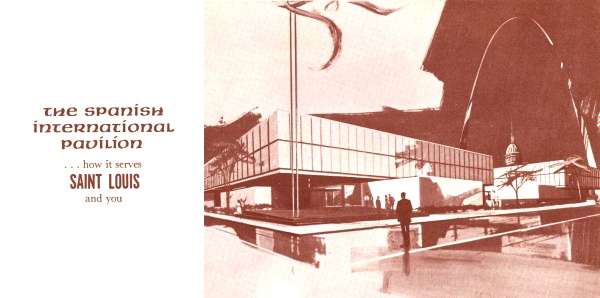
 |
 was the
phrase used by Life Magazine in judging the Spanish International was the
phrase used by Life Magazine in judging the Spanish International |
|
Pavilion as the most outstanding of
the international pavilions at the New York World's Fair of 1964-65.
The beautiful design of the leading
Spanish architect, Javier Carajal, immediately captured the imagination
of Fair visitors and eventually won several coveted prizes as
a commodious expression of the best in contemporary European
styling.
The Spanish International Pavilion is
unlike any other building in the world . . . a truly unique asset
for a city unlike any other. Its exterior lines are clean, classic,
and unadorned. Rough, white closed-in walls form a play of contrasting
masses with a balancing series of gray blocks enclosing the second
level.
|
|
|
The various rooms of the Pavilion open
onto a courtyard, full of plants and flowers, offering a surprise
in space that provides a refreshing interlude of relaxation from
the excitement within.
The interior design of the Pavilion
is a blend of the most ingenious present-day architecture with
native Spanish traditionalism. The gift of the building to Saint
Louis includes a treasure of stained glass, and paint, ceramic
and collage murals. From the 364,000 unusual Flemish pine blocks
that form the Moorish ceilings to the design of glass, cutlery
and table services, every aspect of the Pavilion achieves a unity
and a perfection that is truly as deeply satisfying as a fine
jewel.
|
|
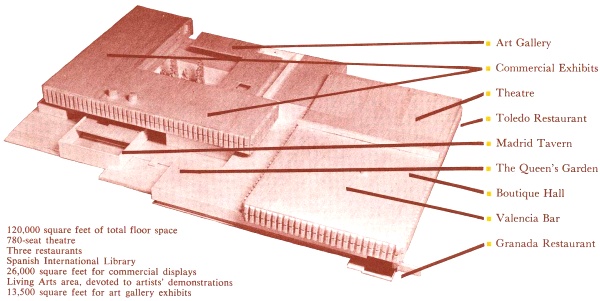
|
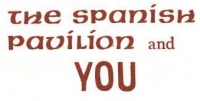
|
The Spanish International Pavilion belongs
to you as a citizen of the Saint Louis area in a special sense.
For you and your neighbors have thus far volunteered more than
17,000 individual donations to help bring the Pavilion to Saint
Louis.
The Pavilion is the result of a spontaneous
outpouring of civic enthusiasm -- the dimes and dollars of the
people of Greater Saint Louis given to a non-profit project of
permanent and growing value to the community. No tax money will
be used, either to reconstructed or operate the Pavilion. The
Pavilion will earn its own way in tourist dollars, and
new tax revenue to Saint Louis.
Each of us in the Saint Louis area .
. . in the City and adjoining counties and on both sides of the
Mississippi . . . has had a rich, new dimension added to our
lives through this wondrous acquisition.
Suddenly, The Spanish International
Pavilion, with its theatre and library, restaurants and patios,
shops and art galleries, becomes a part of our city . . . generating
culture, education, and entertainment for all the people.
No other city can equal it and it belongs
to you. it must have your support. You can help make the pavilion
a debt-free, self-supporting entity that, after 33 years, will
be turned over to the City as a revenue-producing enterprise.
Your contribution, which is tax-deductible, will help the Pavilion
to earn its way to a free and clear status more quickly. Write
your check to The Spanish International Pavilion Foundation,
408 Olive, St. Louis, 63102.
|
|
The Spanish international Pavilion forms
the final third of the fabulous combination that is focusing
the eyes of the world on Saint Louis . . . The "Tourist
Triangle," formed by The Gateway Arch, The Busch Memorial
Sports Stadium, and, now, the Pavilion.
No other city in the world can claim
three such singular attractions in an area of a few blocks: the
breathtaking architectural and engineering triumph of Eero Saarinen
and the tallest U.S. national monument; the magnificent setting
of the Sports Stadium for the excitement of year 'round sporting
events; and the coveted architectural prize of this decade which
only one city could have . . . the Spanish International Pavilion.
Travelers from throughout the world
will be drawn to the "Tourist Triangle" as it becomes
a "must" on every tour of America that dares to be
called complete. The Chamber of Commerce of Metropolitan Saint
Louis and Economic Research Associates, have estimated that the
Spanish International Pavilion alone will create an annual gross
income of $6,000,000. No one can predict the total economic impact
of the "Tourist Triangle" upon this area. But there
can be little doubt that the final measure of benefits . . .
cultural, educational, recreational and economic . . . will be
astronomical.
|

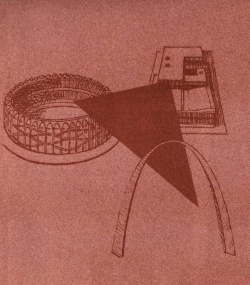
|
 |
The main lobby of the Spanish
International Pavilion.
|
|
|
The symbol of The Spanish International
Pavilion Foundation is a stylized pomegranate enclosed within
a Gateway Arch. The pomegranate, a traditional part of Spain's
Coat of Arms, is rich in historical significance for both America
and Spain. The Spanish for pomegranate is "granda".
It was the victory over the Moors in the City of Granada that
made possible the birth of the Spanish Nation.
The year was 1492 and the triumphant
Queen Isabella granted Christopher Columbus her commission to
explore the New World. The meeting took place in Granada just
after the victory. So it can be said that in the City of the
Pomegranate were formed the beginnings of two great nations whose
common heritage and friendship finds modern expression today
in our Spanish International Pavilion.
|
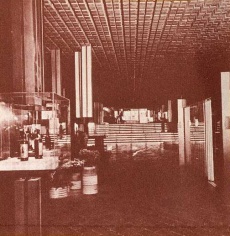 |
The Theatre Lobby Bar.
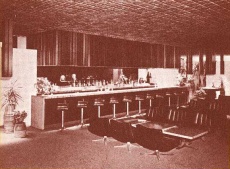 |
|
Spanish entertainment will
be frequently featured in the Pavilion and the flexible facilities
will accommodate a variety of other cultural and theatrical events.
 |
|
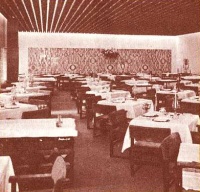 |
- One of the elegant restaurants
- that grace the Pavilion
|
-
Daylight streaming into
the Pavilion's inner courtyard highlights the pomegranate symbol
on the textured walls. Pablo Serrano's statue of Fray Junipero
Serra stands beside the fountain and shrubbery of this serene
area.
|
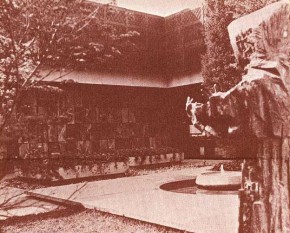 |
 |
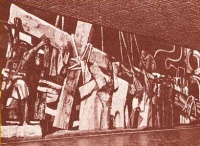
A mural depicting the religious contribution
of Spain to the New World by artist Joaquin Vaquero Turcios.
|
| FACTS ABOUT THE
SPANISH INTERNATIONAL PAVILION |
| Who will operate it? |
The Spanish International Pavilion Foundation,
a non-profit corporation directed by a board of thirty business
and civic leaders. |
| Where will it be located? |
On the square block bounded by Broadway,
Walnut, Market, and Seventh streets, directly on the northern
side of the Stadium. |
|
What will it cost the citizens
of Saint Louis? |
No tax money has or will be used to dismantle,
relocate, or operate the Pavilion. Citizens of the Saint Louis
area have volunteered thousands of donations, but only their
enthusiasm for the Pavilion dictated their actions. |
|
When will it become the property
of the City? |
The Pavilion and all assets of the foundation,
as a debt-free, self-supporting enterprise will become the property
of the City of Saint Louis after 33 years. As a city-owned facility
the Pavilion will produce revenue rather than require appropriations. |
| What will it contribute to Saint
Louis life? |
New jobs and enriched experiences for all
through its displays of fine art and new products, elegant restaurants,
and exciting entertainment. |
|
How much new income will it
generate? |
According to research estimates, a yearly
2,250,000 visitors will produce gross annual revenues of $6,969,000
resulting in a $504,000 annual surplus. |
 |
"The Spanish Pavilion is the Jewel
of the Fair" |
| LIFE MAGAZINE |
| "The Spanish Pavilion is something
on its own, like a luminous star." |
| "Second time around, the Spanish
Pavilion at the World's Fair is the best total work of art in
the whole place." |
| THE NEW YORK TIMES |
| "Spain (has) the most outstanding
national pavilion at the Fair, and worthy, perhaps, of the "Blue
Ribbon for the Best Pavilion." |
| "The most impressive exhibition
of art, this year as last, is the Spanish Pavilion." |
| THE NEW YORK HERALD TRIBUNE |
| Gold Medal of the New York World's Fair |
"Because of its incredible beauty,
the Pavilion of Spain might well remain in Meadow Park for thousands
of years." |
|
|
TIME MAGAZINE |
-
Citation as The Most
Outstanding Building of its Kind in 1964 . . . New York Chapter,
American Institute of Architects
|
"To think that the Pavilion of
Spain has to be dismantled, is to think of one more assault against
culture." |
| THE NEW YORK DAILY NEWS |
Source: Fund
Raising Brochure for the Spanish International Pavilion in Saint
Louis
 |
|
|